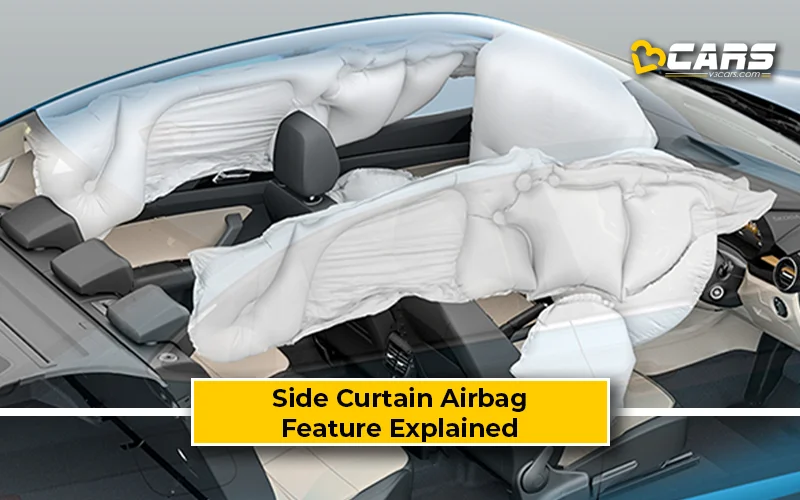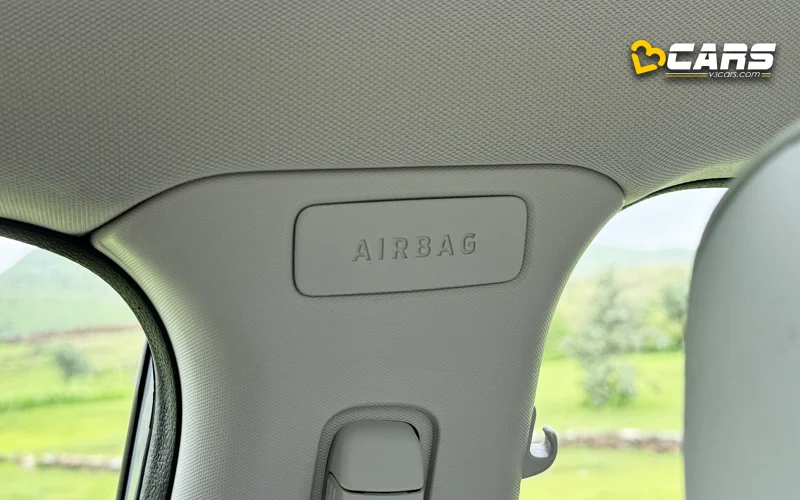Side Curtain Airbag – Feature Explained
While frontal airbags protect you in head-on collisions, and side airbags protect your torso, side curtain airbags are specifically designed to safeguard your head in side-impact collisions and rollovers. Let’s explore this crucial safety feature in detail.

What Is A Side Curtain Airbag?
A side curtain airbag, also known as a “curtain airbag”, “roof airbag” or “overhead airbag,” is an elongated airbag located in the headliner (the fabric lining the car’s roof) above the side windows. It’s designed to deploy downwards, covering the side windows, to protect the head in a side-impact collision or rollover.
How Does A Side Curtain Airbag Work?
Here’s how a side curtain airbag system works:
- Side-Impact And Rollover Sensors: The vehicle is equipped with sensors that can detect both side-impact collisions and the onset of a rollover. These sensors are strategically placed in the doors, B-pillars, and sometimes within the vehicle’s electronic stability control (ESC) system.
- Rapid Detection: These sensors are designed to react very quickly to the sudden changes in velocity, lateral acceleration, and vehicle orientation that occur during a side-impact or rollover event.
- Signal to Inflator: When a side-impact or rollover is detected, the sensors send an electrical signal to the airbag inflator.
- Airbag Inflation: The inflator uses a chemical reaction to generate a large volume of gas (typically argon or nitrogen) in milliseconds. This gas fills the airbag, which deploys downwards from the headliner.
- Cushioning and Containment: The inflated airbag forms a protective curtain that covers the side windows. This curtain cushions the head, preventing it from striking the side pillars, window glass, or objects outside the vehicle. In a rollover, the curtain airbag remains inflated for a longer duration, providing continued protection.
- Deflation: After the initial impact, the airbag deflates through vents, though it may remain partially inflated for some time, especially in a rollover.
What Are The Pros And Cons Of Side Curtain Airbags?
Here are the pros, or advantages, of side curtain airbags:
- Superior Head Protection: Side curtain airbags provide excellent protection against head injuries in side-impact collisions, which are a leading cause of fatalities and serious injuries.
- Rollover Protection: They offer crucial head protection in rollover accidents, where the risk of head injury is very high.
- Protection for Multiple Occupants: Side curtain airbags protect both front and rear outboard passengers.
- Reduced Ejection Risk: In rollovers, they help to prevent occupants from being ejected from the vehicle.
Here are the cons, or disadvantages, of side curtain airbags:
- Limited Torso Protection: Side curtain airbags primarily protect the head. However, they offer no protection to the torso or extremities. This is where the driver side airbag and passenger side airbag come in handy.
- Minor Injuries: Like other airbags, deployment can sometimes cause minor injuries such as abrasions or burns.
- Can be Startling: The sudden deployment can be startling, but this is a temporary effect.
How Does A Side Curtain Airbag Differ From Driver And Passenger Side Airbags?
While all 3 types of airbags are designed for side-impact protection, they differ in location and the area of the body they protect:
- Driver and Passenger Side Airbags: Located in the seatbacks or door panels, they primarily protect the torso (chest and abdomen).
- Side Curtain Airbags: Located in the roof lining (headliner), they deploy downwards to protect the head. They also offer protection in rollover accidents, which driver and passenger side airbags do not.
In short, side airbags protect the body, while side curtain airbags protect the head, and offer additional protection in rollovers.
Is It Possible To Install Side Curtain Airbags From The Aftermarket?
Installing side curtain airbags aftermarket is extremely complex and generally not recommended. Here’s why:
- Complex Integration: It requires extensive modification to the vehicle’s headliner, roof structure, and electrical system, as well as integration with the ECU and sensors.
- Reliability Concerns: Aftermarket systems may not be as reliable or thoroughly tested as factory-installed airbags.
- Safety Risks: Improper installation can lead to deployment failure, unintended deployment, or other malfunctions, potentially causing serious injury or death.
- Structural Integrity: Modifying the roof structure can compromise the vehicle’s structural integrity, especially in a rollover.
- Warranty Issues: Modifying a vehicle’s safety systems can void the manufacturer’s warranty.
What Is The Cost Of Replacing A Side Curtain Airbag?
The cost of replacing a deployed side curtain airbag can vary significantly depending on:
- Vehicle Make and Model: Different vehicles have different airbag systems and replacement part costs.
- Parts Required: In addition to the airbag module itself, other components like the headliner and trim panels may need to be replaced.
- Labour Costs: Installation costs can vary depending on the complexity of the job.
Generally, replacing a side curtain airbag can range from Rs. 10,000 to Rs. 30,000 or more based on the make and model. Rollover deployments are more expensive due to the potential for more extensive damage.
Note: Check your Car EMI with our - Car Loan EMI Calculator
You can use our Fuel Cost Calculator to see how much any petrol, diesel or CNG car will cost to run based on the latest fuel price in your city.



0 Comments